2.11 Uncertainties
2.11 Uncertainties
Systematic updating of the data in the product registers is important, since experience has shown that the general requirement to notify changes does not give satisfactory results. Experience has shown that when the composition of a product is changed, the companies do often not report this to the product registers. This error maybe is smaller in Norway where companies are asked each year if they have updated their composition data.
The total amount of a substance in SPIN is the added quantities of the substance in all products, the export amount subtracted. That is to say that if a substance is registered first as the imported raw material and then as part of the final preparation the quantity will be counted twice. Substances that are used for formulation of chemical products and that are imported, and most are in the Nordic countries, will thus be accounted for with maybe double the actual amount. The accuracy of the total net turnover will be dependent on the use of the substance; a substance imported only for use in synthesis will appear with a more correct quantity. The more disintegrated the use is, the more correct the figure will be, as it is hardly likely that the same molecule will act both as raw material to a trade, formulated and then sold to the same trade again.
Another factor giving a distortion of the quantity value is when concentration has been registered as an interval. The upper limit has been chosen for calculations of the substance amount in Denmark, Finland and Norway. The Swedish data are given as the mean percentage. Depending on how wide the allowed interval is in the different countries the discrepancy between the given value and the true value will vary.
In Sweden the possibility to not declare all ingredients in all concentrations causes uncertainty in the substance quantity figure. This is particularly important when trying to estimate substances that, however hazardous, are active in low percentage. On the other hand the other Nordic product registers mainly contain hazardous chemical products, thus giving an underestimation of both hazardous and not hazardous substances, as they don’t account for quantities in non-hazardous chemical products.
Secrecy rules have made it necessary to exclude data on many substances in SPIN. Thus, addition of subsets will not give a correct answer and can not be compared to the total amount of the substance. Moreover, Danish and Finnish industrial category quantities have been distributed with the entire substance amount for each product on each of the industrial categories given for that product. An addition of such industrial category quantities can give a value both double and triple the total substance amount.
Another obstacle when evaluating industrial category quantities is that in Sweden some industrial categories are only registered on the one digit level. This one digit level substance quantity has been distributed on the underlying two digit levels which may cause an error in allocation, some sub-category getting to much and others too little.
As a result of secrecy considerations some substances in the Nordic product registers are only mentioned in SPIN by their name. Total quantities and the total number of products have not been reported to SPIN if the substance is contained in less than 4 products and is registered by less than 3 companies. To show that the lack of information is due to confidentiality, a “Yes” is stated under the column heading “Confidential” in the “Total use”-window.
Finally it should be mentioned that information about specific substances and polymers only has been reported to SPIN when they have an unambiguous CAS-number.
Please also refer to section 2.12 “limits in the use of data”.
2.10 Codes for technical types of products and preparations (use categories)
2.10 Codes for technical types of products and preparations (use categories)
A few years ago a code list of 62 use categories, UC62, for chemical substances and preparations was developed on the basis of the 55 function categories designed by EU for new substances, later included in the HEDSET for existing substances. These substance categories could with addition of 7 new categories and a few adjustments be used for preparations as well, so the 2-digit key was retained in combination with a single letter indicating the degree of change compared to the substance categories. The Nordic registers (with Finland starting after 2003) report to SPIN using UC62.
Between 1993 and 2001 the product register in Finland used a national list of 36 use categories. In year 2002 the national use categories were changed to the UC62 codes.
The national codes used by the other registers are more detailed than UC62. Denmark and Norway use a code system describing technical function of chemical substances and preparations with practically no reference to the chemical basis. There are about 120 main categories subdivided to more than 400 specific categories.
The Swedish national use categories for report of a product to the products register are specifically created for this purpose. They can mirror the function for which a substance is used or what kind of a preparation the product is. The aim of naming the product types, that are called functions in the nomenclature of the register, has been to use the same naming as the supplier. There are about 220 Swedish use categories that were used up to 2001.
In 2002 a new set of harmonized product type codes, UCN (Use Categories Nordic) have been developed by Norway, Sweden and Denmark. UCN has replaced the existing national codes in these tree countries. In Sweden and Norway the UCN has been used since 2002.
2.1 Background
2.1 Background
The national product registers in Denmark, Finland, Norway and Sweden are unique and very valuable sources of data concerning the downstream uses of chemical substances in products on the national markets.
SPIN – Substances in Preparations In the Nordic countries – is a database that contains “non-confidential” information on substances from each of the Nordic product register.
The intention behind the database SPIN is to make available to the public as much data as possible from the registers. Sometimes secrecy rules can then be an obstacle, something which here is overcome by aggregation of the data from each register. Thereby, the number of products within a certain use or industry category is increased. As a result more information on a greater number of chemical substances can be used e.g. for the purpose of exposure assessment. The information included is for example the number of products containing the substance, the annual tonnage, industrial categories and use categories, the annual tonnage within these categories and the presence or absence of the substance in consumer products.
1.6.3 Reports – using the current found set
1.6.3 Reports – using the current found set
When you have found a specific set of records by searching as described in the sections 1.3.1, 1.3.2, 1.3.3 and 1.3.4 you can run the reports “Simple List” and “List Substances” from the report window on the basis of your current found set.
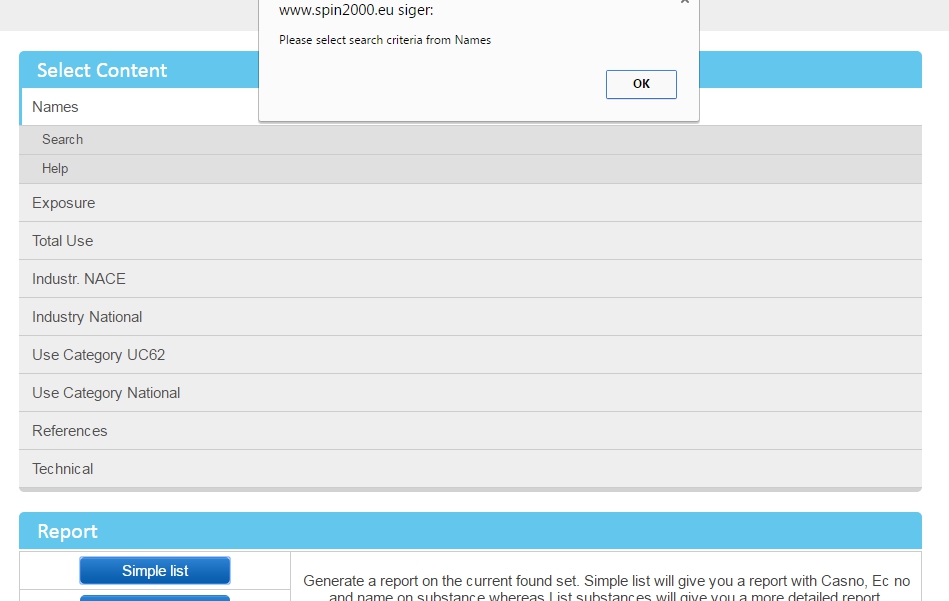
Pressing the “Simple List” button gives you a list of the substances in your current set identified by their CAS-No., EC-No. and name. You can either print the report on paper, or you can save it as a file using the standard web features.
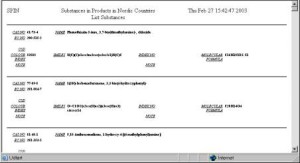
Pressing the ” List Substances ” button gives you a report of all the “technical” information about the substances in your current set. These are CAS-No., EC-No., CSD, C.I.-No., name, SMILES, Index-No. and molecular formula. To learn more about these substance data, please refer to section “1.6.6 On-line help – Technical”. If there are empty fields in some of the technical data fields in the “Substance data” report it is not because of error, but lack of data. Lots of substances do not have data in all of the listed fields. Again you can either print the report on paper, or you can save it as a file using the standard web features.
1.6.2 UC62 Report
1.6.2 UC62 Report
For a selected Nordic country and year, the UC62 Report gives you an overview of the total volume of each specific substance and the total number of preparations containing this substance in a selected category of technical function (use category) of the preparations containing the substance. Country, year and use category are selected from drop down menus in the top of the report before the “find” button is pressed. The use categories that are used follows the UC62 system as described in section “1.6.4 On-line help – Use by category”.
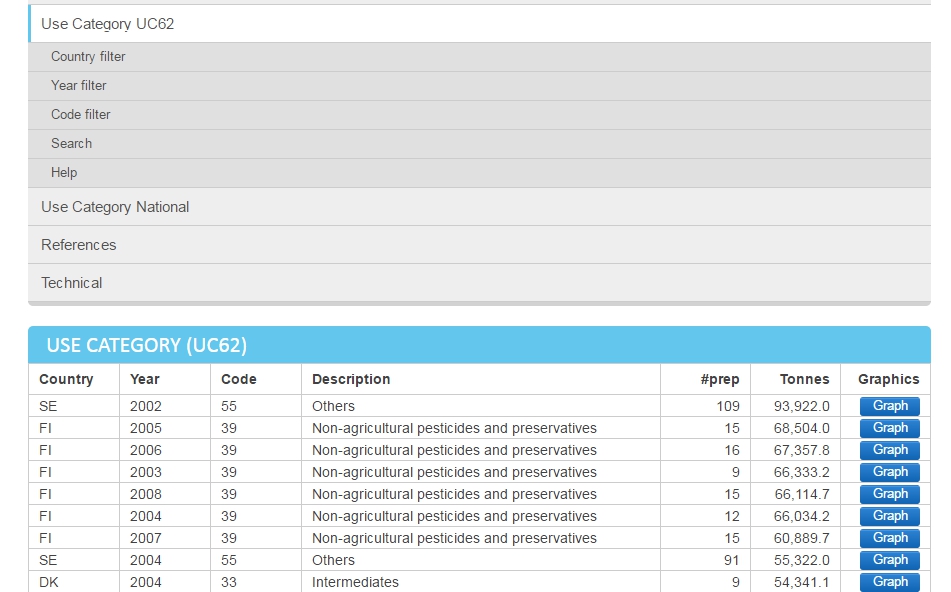
When you press the “Find” button after country, year and UC62 code have been selected, the substances are listed with the higher volumes first. Please note that if the total volume of a substance equals “0,0”, it only means that it is below the limit of accuracy, which is 100 kg.
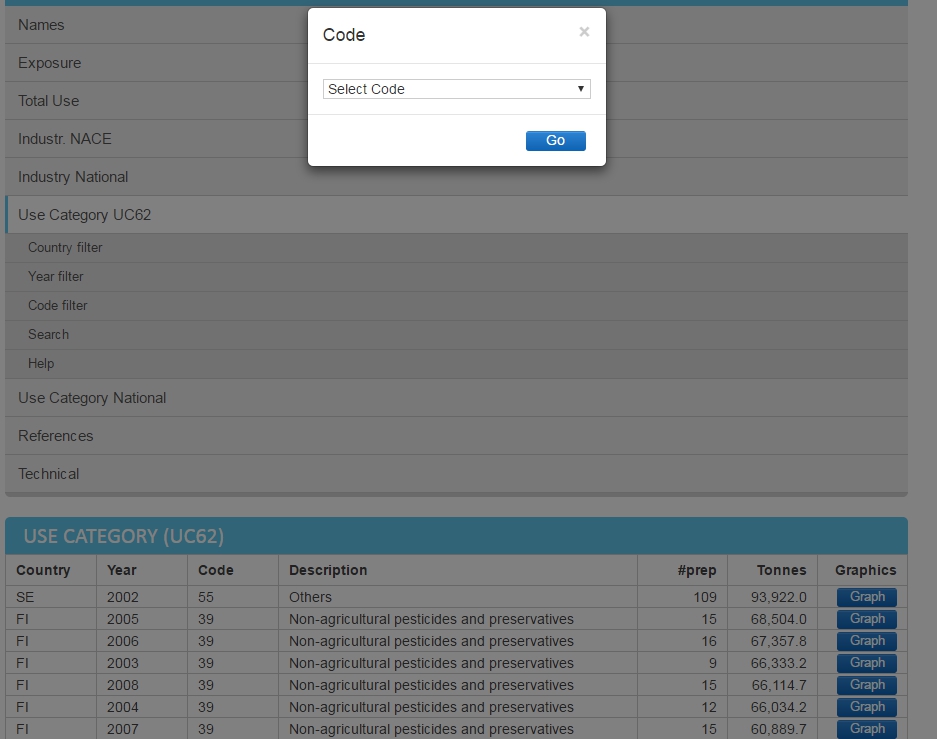
If you press the button “Return from report” you will be returned to the report window. If you press the “Print report” button, a preview of the printed report will appear. From here you can either print the report on paper, or you can save it as a file using the standard web features. Pressing the “New search” button resets the report and new parameters can be selected.
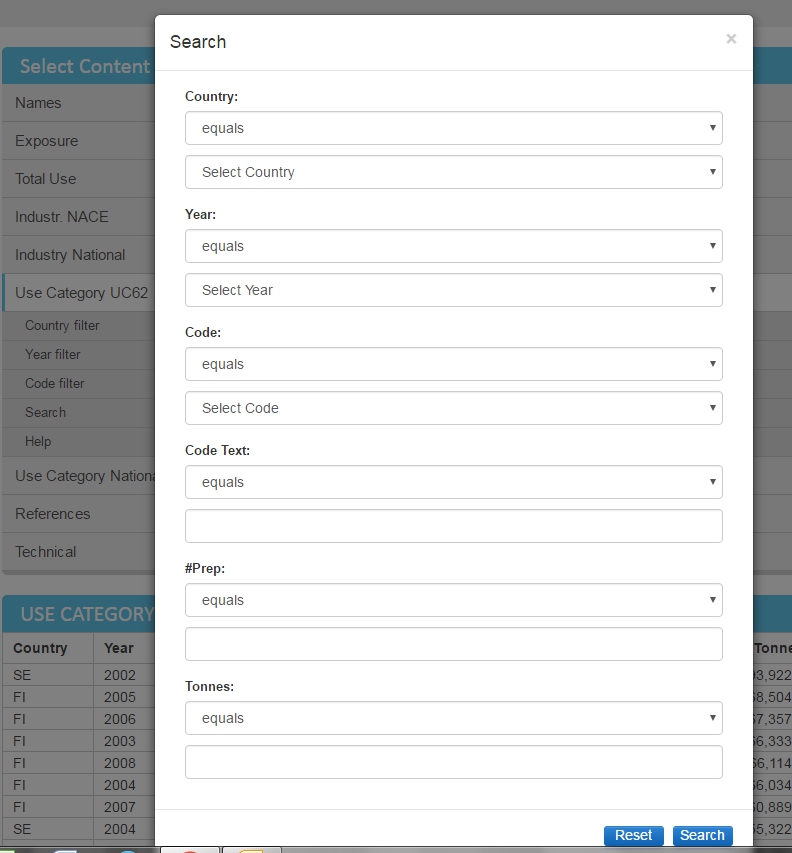
1.6 Reports in SPIN
1.6 Reports in SPIN
In the header of the report window the “List” and “Show All” buttons works in the same way as described in section “1.3.1 Searching in SPIN”. Pressing the “Guide” button opens the guide window and pushing the “Exit” button finishes the session and closes down the SPIN application. If you want to return to one of the information tabs, you simply press the title of the tab that you want to return to.

In the report window you can choose between 4 different reports. To activate a certain report you simply press the button with the report title. You must however perform a search (see the sections 1.3.1, 1.3.2, 1.3.3 and 1.3.4) before being able to work with the reports “Simple List” and “List Substances”. This is not necessary, when you are only working with “Nace Report” and “UC62 Report”.
1.5.6 On-line help – Technical
1.5.6 On-line help – Technical
The tab called “Technical” includes all of the “technical” information about the substance.
Molecular formula:
The molecular formula summarises the number of different atoms in the substance molecule, shown by the atomic symbols and their different counts.
Index No.:
The Index No. is an identification number used for substances that are officially recognized as dangerous by the European Commission and are entered on the E.C. List of Dangerous Substances (Annex I of directive 67/548/EEC with later adjustments). In the case of 1,4-benzenediamine below, the substance is classified by the E.C. as a substance that is toxic for humans and very toxic for the environment with allergenic and eye irritating properties (T;R23/24/25 Xi;R36 R43 N;R50/53). Substances without Index No. are not yet recognized as dangerous by the E.C., but that does not necessarily mean that they are harmless. In cases like that, the dangerous properties has to be assessed by the supplier of the substance.

SMILES:
SMILES is an acronym, meaning Simplified Molecular Input Line Entry Specification. It represents a valence model of the substance molecule and can be interpreted by computer programs to make a drawing of the molecular structure or a model calculation of physical, chemical and/or dangerous properties. You can get drawings of molecular structures like that of 1,4-benzenediamine by pressing the “Show structure” button. This will bring you directly to a homepage where the structure is depicted.
Colour Index:
The Colour Index Number, often abbreviated as C.I.-No. or just C.I., is the identification number used in Colour Index, the handbook of pigments and dyes first published in 1925, now published on the web by the Society of Dyers and Colourists and the American Association of Textile Chemists and Colorists. Please note that not all pigments and dyes in SPIN have a C.I.-No., either because it has not been registered, or because it has not been assigned for reasons of confidentiality. You can learn more about Colour Index at the homepage http://www.colour-index.org
CSD:
CSD is an acronym, meaning Chemical Substances Definition. It is used in the European list of existing substances (EINECS) and in the E.C. List of Dangerous Substances to give a more detailed description of naturally or technically occurring mixtures of substances, such as oil fractions derived from crude oil and similar mixtures. An example could be the CSD for “Fuel oil No. 6” with the Index-No. 649-030-00-1 and the CAS-No. 68553-00-4. The CSD for this “substance” says: “A fuel oil with a minimum viscosity of 195 cSt and a maximum viscosity of 1950 cSt at 37,7 ° C”.
Substance category:
The substance category code is a code used by the Danish Product Register to describe the assumed technical function of the substance as a component of a preparation. You can see the full list of substance categories in “3.4 Substance categories (Danish)” in the SPIN guide.
Main category (IUCLID):
Categories of use pattern as recorded in the IUCLID database. IUCLID stands for International Uniform Chemical Information Database. The database has been developed with a view to fulfilling the requirements of Council Regulation (EEC) no. 793/93 on the evaluation and control of the risks of existing chemicals and is situated in ECB, Ispra. You can see the full list of main categories in “3.3 Main Category (IUCLID)” in the SPIN guide.
1.5.5 On-line help – References
1.5.5 On-line help – References
Where data are present, the tab “References” contains information about the chemical relations of the given substance and information about various official inventories that might include it.
Inventories:
If a given substance is included in an official inventory, e.g. the Danish inventory of carcinogenic substances, and the inventory is included in SPIN, then the code and title of the inventory will appear in the inventory list under the title “Inventories”. The inventories in SPIN will typically either be connected to regulation (as the Danish inventory of carcinogenic substances), science (substances with certain properties) or politics (as the Danish list of undesirable substances).
Components:
In many cases the name and a CAS-No. not only covers one specific substance, but a mixture or compound of different substances. This often proofs to be the case with polymers and isomeric mixtures, where the “substance” in reality is a sometimes inseparable mixture of substances resulting from a chemical reaction. In SPIN these “substances” are described by their chemical building blocks, the substances that reacted chemically to form the mixture, under the title “Components”. In the case below, the “substance” is propoxypropanol formed from the components 1,2-propanediol and 1-propanol.
References:

If the isomers of the “substance” are known they will be listed under the title “References”. In the case below there is only 1 isomer: 1-propoxy-2-propanol.
1.5.4 On-line help – Use by category
1.5.4 On-line help – Use by category
The tabs called “Use by category (UC62)” and “Use by Category” gives you an overview of the technical use of preparations that contains the selected substance. When you first enter the tabs, they will show you the data from all contributing countries distributed on all reported codes from all the reported years, respectively. By pressing one of the button-shaped headings “Country”, “Year” or “Code”, you can get a more specific view. To learn more about specific selection of “use data” please see “1.4.1 Selecting specific “use data” on the screens” in the SPIN guide.
Country:
The countries that has contributed to SPIN with data from their national product registers are:
- NO: Norway
- SE: Sweden
- DK: Denmark
- FI: Finland.
There are no product register data from Iceland.
Year:
Data are reported to SPIN on a yearly basis. The data reflects the current status of the technical types of preparations that contains the substance in that particular year in the reporting country.
Code:
In the “Use by category (UC62)” tab the technical function af the preparations containing the substance is described by a UC62 code (Use Code 62). The 62 different use categories of UC62 represents a development of the 55 use categories for substances in the context of directive 79/831/EEC, Notif 23/90 – rev 5. The original 55 use categories were made to be suitable for substances. The extension with 7 more categories makes UC62 suitable for preparations as well.

In the “Use by Category” tab the use of the preparations containing the substance are presented by national use categories for registration of technical functions of preparations. They usually operate on a more detailed level than the 2 digit code in the “Use by category (UC62)” tab. Therefore data that might be included in the overall presentation in the “Use by category (UC62)” tab might be partly or totally suppressed in the “Use by Category” tab due to confidentiality. To learn more about UC62 and the national use categories, please refer to section “3.1 Use categories” under the tab called “3. Codes” in the SPIN guide.
Please refer to section “2.11 Uncertainties” under the “2. General info” tab in the SPIN guide for further information about confidentiality.
# preparations:
Number of preparations is the total registered count of preparations containing the substance used in the particular technical types of preparations in the particular year in the reporting country.
Tonnes:
“Tonnes” represents the registered volume of the substance in the particular year used in the particular technical types of preparations in the reporting country. If the value is “0.0” it means that the volume is below the limit of accuracy, which is 100 kg.
The sum of “Use by category” volumes and the “Total use” volume (see section “1.6.2 Total use”) for a specific substance used in a specific country cannot be compared. Partly because a certain volume can be presented with more than one code, partly because the distribution on codes often results in a number of preparations below the limit of confidentiality, which means that code and volume cannot be presented.
Please note that there are no Finnish volumes from the years 1999 and 2000, because Finland cannot report information about volumes earlier than year 2001.
1.5.3 On-line help – Industrial use
1.5.3 On-line help – Industrial use
The tabs called “Industrial use (NACE)” and “Industrial Use” gives you an overview of the industrial use of the selected substance. When you first enter the tabs, they will show you the data from all contributing countries distributed on all reported codes from all the reported years, respectively. By pressing one of the button-shaped headings “Country”, “Year” or “Code”, you can get a more specific view. To learn more about specific selection of “use data” please see “1.4.1 Selecting specific “use data” on the screens” in the SPIN guide.
Country:
The countries that has contributed to SPIN with data from their national product registers are:
- NO: Norway
- SE: Sweden
- DK: Denmark
- FI: Finland.
There are no product register data from Iceland.
Year:
Data are reported to SPIN on a yearly basis. The data reflects the current status of the industrial use of the substance in that particular year in the reporting country.

Code:
The industrial code used in the tab “Industrial use (NACE)” is the same for all the reporting countries. All the Nordic product registers use the NACE code, which is the statistical classification of economic activities in the European Community, that is also embodied in the EEA Agreement by the EFTA countries. The NACE codes indicate the branches of industry where the products are used. In the “Industrial use (NACE)” tab the NACE code is used at a 2-digit level to ensure, that not too many data has to be suppressed due to confidentiality.
In the “Industrial use” tab national industry groups based on NACE are presented. They usually operate on a more detailed level than the 2 digit code in the “Industrial use (NACE)” tab. Therefore data that might be included in the overall presentation in the “Industrial use (NACE)” tab might be partly or totally suppressed in the “Industrial Use” tab due to confidentiality. To learn more about the national industry groups, please refer to section “3.2 Industrial Categories” under the tab called “3. Codes” in the SPIN guide.
Please refer to section “2.11 Uncertainties” under the “2. General info” tab in the SPIN guide for further information about confidentiality.
# preparations:
Number of preparations is the total registered count of preparations containing the substance used in the particular part of industry in the particular year in the reporting country.
Tonnes:
“Tonnes” represents the registered volume of the substance in the particular year used in the particular part of industry in the reporting country. If the value is “0.0” it means that the volume is below the limit of accuracy, which is 100 kg.
The sum of “Industrial use” volumes and the “Total use” volume (see section “1.6.2 Total use”) for a specific substance used in a specific country cannot be compared. Partly because a certain volume can be presented with more than one code, partly because the distribution on codes often results in a number of preparations below the limit of confidentiality, which means that code and volume cannot be presented.
Please note that there are no Finnish volumes from the years 1999 and 2000, because Finland cannot report information about volumes earlier than year 2001.










